
Gapyeong Canada Monument
Encyclopedia
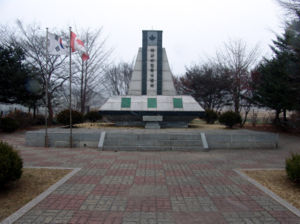

Canadian Forces
The Canadian Forces , officially the Canadian Armed Forces , are the unified armed forces of Canada, as constituted by the National Defence Act, which states: "The Canadian Forces are the armed forces of Her Majesty raised by Canada and consist of one Service called the Canadian Armed Forces."...
during the Korean War
Korean War
The Korean War was a conventional war between South Korea, supported by the United Nations, and North Korea, supported by the People's Republic of China , with military material aid from the Soviet Union...
, especially at the Battle of Kapyong
Battle of Kapyong
The Battle of Kapyong , also known as the Battle of Jiaping , was fought during the Korean War between United Nations forces—primarily Australian and Canadian—and the Chinese communist People's Volunteer Army...
in the Canadian Korean War Memorial Garden. The English
English language
English is a West Germanic language that arose in the Anglo-Saxon kingdoms of England and spread into what was to become south-east Scotland under the influence of the Anglian medieval kingdom of Northumbria...
text describing the monument reads as follows:
When one walks toward the monument, at the left is a panel explaining the history of the monument while at the right is a description of the Canadian contribution to the Korean War. The main monument is centred at the far end alongside both a Korean
Flag of South Korea
The flag of South Korea, or Taegeukgi has three parts: a white background; a red and blue taegeuk in the centre; and four black trigrams, one in each corner of the flag...
and Canadian flag. The main monument is flanked left by the monument dedicated to the 2nd Battalion Princess Patricia's Canadian Light Infantry
Princess Patricia's Canadian Light Infantry
Princess Patricia's Canadian Light Infantry is one of the three regular force infantry regiments of the Canadian Army. The regiment is composed of four battalions including a primary reserve battalion, for a total of 2,000 soldiers...
(PPCLI) and the battle on Hill 677 and flanked on the right with another monument naming all the Canadian units that participated in the Korean War.
The Main monument
The main monument was erected December 30, 1983 and its English text reads as follow :PPCLI monument
At the left of the main monument lies the monument dedicated to the 2nd Battalion of the Princess Patricia Canadian Light Infantry for their actions during the Battle of Kapyong on April 24 and 25 1951, actions that had them decorated with the United StatesUnited States
The United States of America is a federal constitutional republic comprising fifty states and a federal district...
Presidential Unit Citation. This monument was erected November 7 1975.
Canadian contribution to the Korean War
The two rightmost monument describe the Canadian contribution to the Korean war. The front monument reads as follow s:The rear monument goes into details, listing the units that participated in the Korean war as well as the size of the contribution: 26,791 Canadians during the war itself, 7,000 until 1955 with 516 casualties and 1,255 wounded. The units that served are:
- Royal Canadian NavyRoyal Canadian NavyThe history of the Royal Canadian Navy goes back to 1910, when the naval force was created as the Naval Service of Canada and renamed a year later by King George V. The Royal Canadian Navy is one of the three environmental commands of the Canadian Forces...
- HMCS AthabaskanHMCS Athabaskan (R79)HMCS Athabaskan was the second destroyer of the Royal Canadian Navy to bear the name Athabaskan, after the many tribes throughout western Canada that speak Athabaskan family languages. Its pennant was later changed to DDE219...
- HMCS CayugaHMCS Cayuga (R04)HMCS Cayuga R04/218 was a Tribal class destroyer built in the Halifax Shipyards, Halifax, Nova Scotia and served in the Royal Canadian Navy.-History:...
- HMCS SiouxHMCS Sioux (R64)HMCS Sioux was a V class destroyer of the Royal Canadian Navy that saw service in World War II.She was launched as HMS Vixen for the British Royal Navy...
- HMCS NootkaHMCS Nootka (R96)HMCS Nootka was a Tribal-class destroyer that served in the Royal Canadian Navy from 1946-1964.She received the unit name Nootka while still under construction in Halifax after the RCN renamed the Fundy-class minesweeper to in 1943....
- HMCS HuronHMCS Huron (G24)HMCS Huron G24/216 was a Tribal class destroyer built by Vickers-Armstrongs on the River Tyne in England, and served in the Royal Canadian Navy. It was the first ship to bear this name...
- HMCS IroquoisHMCS Iroquois (G89)-External links:** at Haze Gray and Underway*...
- HMCS Crusader
- HMCS HaidaHMCS Haida (G63)HMCS Haida is a Tribal-class destroyer that served in the Royal Canadian Navy from 1943-1963.Haida sank more enemy surface tonnage than any other Canadian warship...
- HMCS Athabaskan
- ArmyHistory of the Canadian ArmyThe Canadian Army as such originally only existed under that name from November 1940 to February 1968. However, the term has been traditionally applied to the ground forces of Canada's military from Confederation in 1867 to the present...
- Lord Strathcona's Horse (Royal Canadians)Lord Strathcona's Horse (Royal Canadians)Lord Strathcona's Horse is a regular armoured regiment of the Canadian Forces. Currently based in Edmonton, Alberta, the regiment is part of Land Force Western Area's 1 Canadian Mechanized Brigade Group...
- 2nd Field Regiment (FD Regt.) and 1st Regt. Royal Canadian Horse ArtilleryRoyal Canadian Horse ArtilleryThe Royal Canadian Horse Artillery is the name given to the regular field artillery units of the Canadian Army. RCHA units are the senior units of the Canadian land field force, with a history dating back to the birth of Canada as a nation...
- 81st FD Regt. Royal Canadian ArtilleryRoyal Regiment of Canadian ArtilleryThe Royal Regiment of Canadian Artillery is the artillery personnel branch of the Canadian Forces .-History:...
- The Corps of Royal Canadian EngineersCanadian Military EngineersThe Canadian Military Engineers is the military engineer branch of the Canadian Forces.-Mission:The mission of the Canadian Military Engineers is to contribute to the survival, mobility, and combat effectiveness of the Canadian Forces...
- The Royal Canadian Corps of SignalsRoyal Canadian Corps of SignalsThe Royal Canadian Corps of Signals was a corps of the Canadian Army. Major Wallace Bruce Matthews Carruthers established the corps in 1903, making it the first independent Signal Corps in the British Empire...
- The Royal Canadian RegimentThe Royal Canadian RegimentThe Royal Canadian Regiment is an infantry regiment of the Canadian Forces. The regiment consists of four battalions, three in the Regular Force and one in the Primary Reserve...
- 2nd. 1st and 3rd Battalions
- Princess Patricia's Canadian Light InfantryPrincess Patricia's Canadian Light InfantryPrincess Patricia's Canadian Light Infantry is one of the three regular force infantry regiments of the Canadian Army. The regiment is composed of four battalions including a primary reserve battalion, for a total of 2,000 soldiers...
- 2nd. 1st and 3rd Battalions
- Royal 22e RégimentRoyal 22e RégimentThe Royal 22nd Regiment is an infantry regiment and the most famous francophone organization of the Canadian Forces. The regiment comprises three Regular Force battalions, two Primary Reserve battalions, and a band, making it the largest regiment in the Canadian Army...
- 2nd. 1st and 3rd Battalions
- The Royal Canadian Army Service CorpsRoyal Canadian Army Service CorpsFor successor see Logistics BranchThe Royal Canadian Army Service Corps was an administrative and transport corps of the Canadian Army....
- The Royal Canadian Army Medical CorpsRoyal Canadian Army Medical CorpsThe Royal Canadian Army Medical Corps was an administrative corps of the Canadian Army. The Militia Medical Service was established in 1899. The Militia Medical Service was redesignated the Canadian Army Medical Corps in 1904. The Canadian Army Medical Corps was redesignated The Royal Canadian...
- The Royal Canadian Army Dental CorpsRoyal Canadian Dental CorpsThe Royal Canadian Dental Corps was an administrative corps of the Canadian Army. The Canadian Dental Corps was authorized on 31 Aug 1939. The Regular and Reserve components of the Canadian Dental Corps were collectively redesignated The Royal Canadian Dental Corps on 15 Jan 1947...
- Royal Canadian Army Ordnance CorpsRoyal Canadian Ordnance CorpsThe Royal Canadian Ordnance Corps was an administrative corps of the Canadian Army. The Royal Canadian Ordnance Corps RCOC can trace its roots back to the Canadian Stores Department. Formed in 1871, the Canadian Stores Department was a civil department of the Canadian Government...
- The Corps of Royal Canadian Electrical and Mechanical EngineersElectrical and Mechanical Engineering BranchThe Electrical and Mechanical Engineering Branch is a personnel branch of the Canadian Forces that provides army engineering maintenance support.-History:...
- Royal Canadian Army Pay CorpsRoyal Canadian Army Pay CorpsThe Royal Canadian Army Pay Corps was an administrative corps of the Canadian Army with its own cap badge, and other insignia and traditions. It was established in 1906 as the Canadian Army Pay Corps. It was responsible for administering all financial matters.The Canadian Army Pay Corps began...
- The Royal Canadian Postal CorpsRoyal Canadian Postal CorpsFor successor see Logistics BranchThe Royal Canadian Postal Corps was an administrative corps of the Canadian Army. The Canadian Postal Corps was redesignated the Royal Canadian Postal Corps on 20 Jun 1961. The crest of the Royal Canadian Postal Corps consists of a horn, with a Queen's Crown on...
- Royal Canadian Army Chaplain CorpsRoyal Canadian Army Chaplain CorpsThe Royal Canadian Army Chaplain Corps was an administrative corps of the Canadian Army. The Canadian Army Chaplain Corps was authorized on 22 Mar 1948. The Canadian Army Chaplain Corps was redesignated The Royal Canadian Army Chaplain Corps on 3 Jun 1948. The Royal Canadian Army Chaplain Corps...
- The Canadian Provost CorpsCanadian Provost CorpsThe Canadian Provost Corps was the military police corps of the Canadian Army. The Canadian Provost Corps was authorized on 15 Jun 1940. The Canadian Provost Corps was amalgamated into the Canadian Forces in 1968.-Canadian Military Police Corps:...
- Canadian Intelligence CorpsCanadian Intelligence CorpsThe Canadian Intelligence Corps was an administrative corps of the Canadian Army.-History:Many Canadians were active in the Intelligence field as early as 1939. Major John P...
- Lord Strathcona's Horse (Royal Canadians)
- Royal Canadian Air ForceRoyal Canadian Air ForceThe history of the Royal Canadian Air Force begins in 1920, when the air force was created as the Canadian Air Force . In 1924 the CAF was renamed the Royal Canadian Air Force and granted royal sanction by King George V. The RCAF existed as an independent service until 1968...
- No. 426 (Thunderbird) SquadronNo. 426 Squadron RCAF426 Transport Training Squadron is a unit of the Canadian Forces under Royal Canadian Air Force, located at CFB Trenton in Trenton, Ontario. It originated as a squadron in the Royal Canadian Air Force that fought during the Second World War as a bomber squadron.The motto of the squadron is "On...
- No. 426 (Thunderbird) Squadron
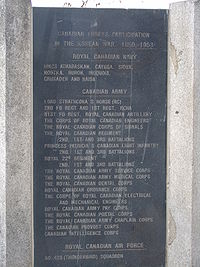 |
 |
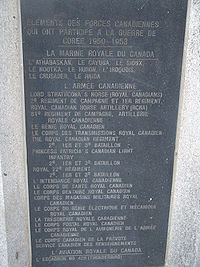 |
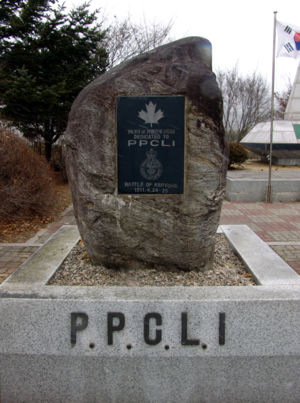 |
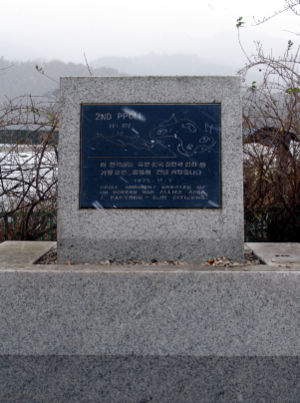 |
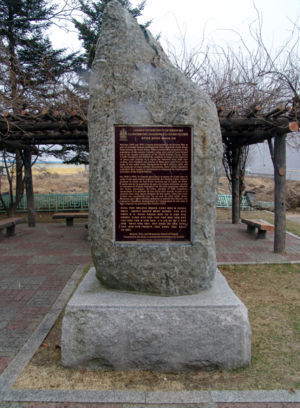 |

